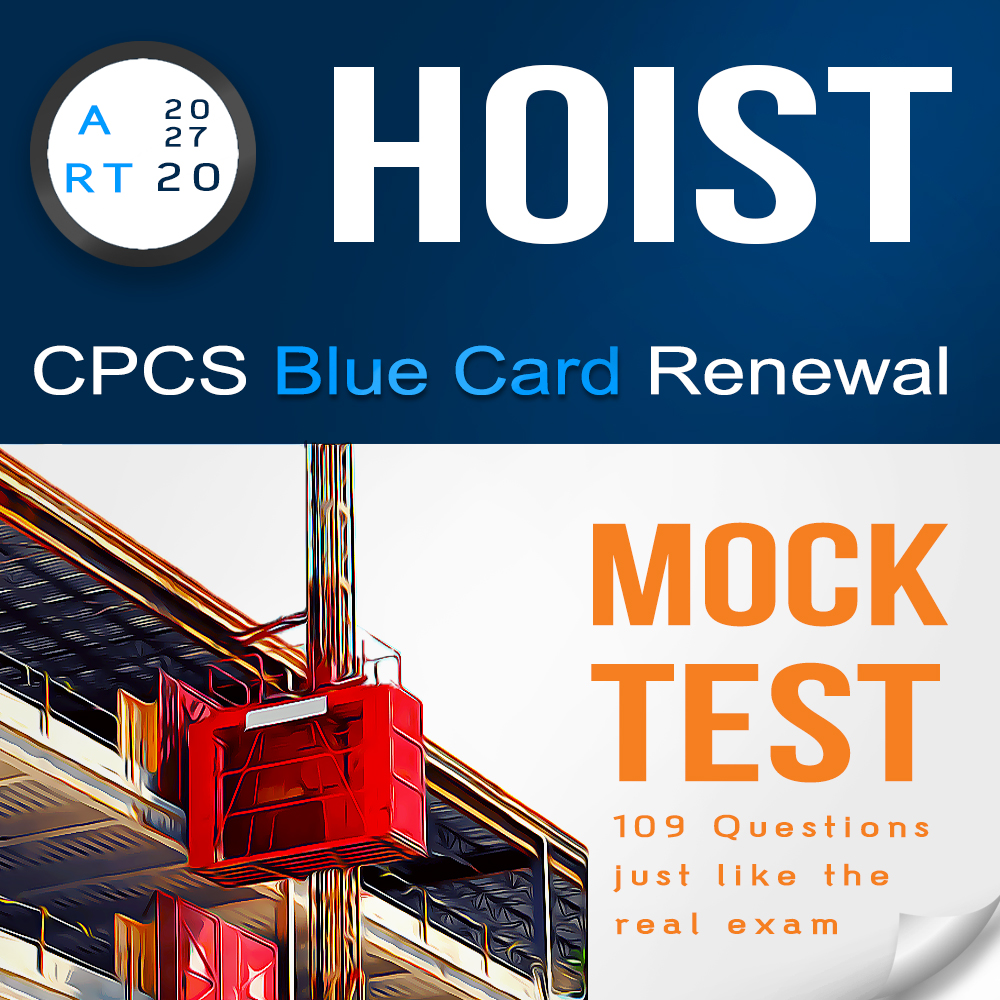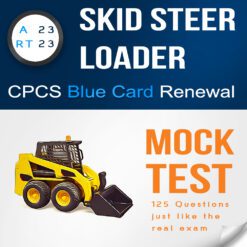RT20 CPCS Blue Card Renewal Mock Test with 109 Questions and Answers / A20 Hoist & A27 MEWP Mast Climber
£15.00 Original price was: £15.00.£9.95Current price is: £9.95.
RT20 Hoist Blue Card Renewal: Sharpen Your Skills with Our Mock Test and 100% PASS Your Touch Screen Test.
- Questions & Answers: based on the latest RT 20 Hoist – CPCS Renewal Test Revision FACTSHEET
- Categories: A20 Hoist
- You can also renew this extra category with the same test: A27 M.E.W.P. Mast Climber
- Number of Multiple-choice Questions: 109
- Format: PDF
- Delivery time: Instant download after checkout
- Refunds: No refunds once downloaded, unless you ordered duplicates by mistake.
If there are any issues with your download, please email CardRenewalTest@gmail.com and we’ll send it ASAP
Master Your RT20 Hoist CPCS Blue Card Renewal with Our Mock Practice Test
Unlock Success in Your CPCS Blue Card Renewal Journey
Renewing your CPCS blue card for the RT20 Hoist doesn’t have to be a daunting task. Whether you’re a seasoned hoist operator or someone looking to extend their blue card for another five years, our RT20 Hoist CPCS Blue Card Renewal Mock Practice Test is the key to mastering the renewal process.
Your CPCS blue card is not just a piece of plastic – it represents your competency and expertise as a hoist operator. As the industry evolves, staying updated on the latest regulations and safety measures is crucial. Renewing your blue card ensures that you are not only compliant but also well-versed in the newest standards, making you a valuable asset on any construction site.
The Challenge of Renewal Tests
Renewal tests can be challenging, especially if you’ve been out of practice or are facing the updated RT20 Hoist factsheet. Reading through extensive documents may not be the most effective way to prepare. That’s where our RT20 Hoist CPCS Blue Card Renewal Mock Practice Test comes in – a tailored solution to help you navigate the renewal process with confidence.
What Sets Our Mock Practice Test Apart?
- Comprehensive Coverage: Our mock test includes 109 multiple-choice questions based on the latest NOCN CPCS RT20 Hoist factsheet. We cover every crucial aspect of hoist operation to ensure you’re well-prepared.
- Realistic Simulation: Mimicking the actual exam environment, our practice test offers a realistic simulation of the CPCS renewal test, giving you a feel for the format and pacing.
- Immediate Feedback: Receive instant feedback on your answers with clear explanations. Learn from your mistakes and reinforce your understanding of key concepts.
- Convenient Learning: No need to sift through lengthy texts. Our mock practice test condenses essential information into bite-sized questions and answers, making it an efficient and convenient study resource.
How to Pass Your CPCS Blue Card Renewal Test
- Study Smart, Not Hard: Focus your efforts on targeted and relevant questions rather than overwhelming yourself with extensive texts.
- Practice Regularly: Consistent practice is the key to success. Our mock test allows you to integrate short study sessions into your routine.
- Understand the Latest Standards: Stay updated on the most recent RT20 Hoist factsheet, ensuring your knowledge aligns with the current industry standards.
Your Journey to Blue Card Excellence Starts Now
Embrace the challenge of renewing your CPCS blue card with confidence. Our RT20 Hoist CPCS Blue Card Renewal Mock Practice Test is not just a study resource; it’s your pathway to mastery and a successful renewal. Start your journey today and secure your place as a competent and skilled hoist operator on construction sites nationwide.
Visit cardrenewaltest.co.uk to access the mock practice test and elevate your CPCS blue card renewal experience. Remember, success is just a test away!
The key points from the RT20 Hoist Factsheet:
The RT20 Hoist factsheet covers a range of topics crucial for safe hoist operation, including preparation, safety systems, emergency procedures, load transportation, scaffold transport, weather considerations, and working safely. Operators must be well-versed in these aspects to ensure a comprehensive understanding of hoist operation and safety protocols.
Preparation for Work (Preparation):
- Hoists are platforms or cages transporting goods, people, or both to different levels.
- Platforms mainly transport goods, while cages are for people. They’re attached to a fixed vertical mast.
- Various methods elevate platforms, such as winch and rope pulley systems or rack and pinion systems.
Safety and Checks:
- Thorough pre-use checks, following manufacturer’s requirements, are crucial.
- Operator’s manual contains vital information; it must be kept with the hoist for reference.
- Familiarisation training is essential for operators to understand specific requirements for different hoist types.
Emergency Procedures:
- Key checks include testing the emergency lowering system, especially on hoists carrying an operator.
- Landing gates’ electric interlock system prevents movement unless gates are properly shut.
- Area beneath the platform must be sealed off to prevent unauthorized entry during hoist operation.
Safety Systems:
- Hoists should have safety features like emergency-stop buttons, to be checked before work starts.
- Limit switches prevent the cage or platform from exceeding safe limits; adjustments should only be done by qualified staff.
Transporting Loads (Working Tasks):
- Platforms and cages have maximum weight limits, crucial to avoid overloading.
- Operators must consider the weight of materials loaded at different landings to maintain balance.
- Combining materials and personnel requires careful loading to avoid trip hazards and injuries.
- Placement of loads should be central, and if close to the maximum weight, contact the hoist installation company to avoid imbalance.
Scaffold Transport:
- Hoists are used by scaffolding teams to transport materials, and special platforms may be used for scaffold tubing.
- When carrying scaffold tubing, de-rating may be necessary if loads are unevenly distributed.
Weather Conditions and Wind Safety:
- Hoists, used for multi-storey structures, are exposed to weather conditions. Operators must be aware of wind speeds and changes in direction.
- Operations must be shut down if wind speeds exceed the manufacturer’s criteria.
- Wind gusts and funnelling effects between buildings must also be considered.
Working Safely:
- Operators must ensure gates and platform doors are properly shut, locked, and secured during operation.
- Goods only hoists are not designed for persons; only members of the erection team can travel during specific activities.
- Passenger-carrying hoists with upper platforms are used only during emergency lowering for accessing the braking system.
- Ground-based controls are for emergencies during people transportation.
Emergency Lowering Process:
- On single-masted hoists, emergency lowering should be safe for a single person within the cage, lowering only to the next available landing.
- A rescue plan is needed for possible mechanical malfunctions trapping people at height, communicated to all operators.
3 reviews for RT20 CPCS Blue Card Renewal Mock Test with 109 Questions and Answers / A20 Hoist & A27 MEWP Mast Climber
Add a review Cancel reply
Related products
CPCS Blue Card Renewal Tests
RT41 CPCS Blue Card Renewal Mock Test with 118 Questions and Answers / A41 Loader Compressor
CPCS Blue Card Renewal Tests
RT45 CPCS Blue Card Renewal Mock Test with 110 Questions and Answers / A 45,46,47,48 Piling Rig
CPCS Blue Card Renewal Tests
CPCS Blue Card Renewal Tests
RT09 CPCS Blue Card Renewal Mock Test with 112 Questions and Answers / A09 Forward Tipping Dumper
CPCS Blue Card Renewal Tests
RT43 CPCS Blue Card Renewal Mock Test with 102 Questions and Answers / A43 Screener
CPCS Blue Card Renewal Tests
RT23 CPCS Blue Card Renewal Mock Test with 125 Questions and Answers / A23 Skid Steer Loader
CPCS Blue Card Renewal Tests
RT65 CPCS Blue Card Renewal Mock Test with 133 Questions and Answers / A65 Demolition Plant
CPCS Blue Card Renewal Tests
RT66 CPCS Blue Card Renewal Mock Test with 133 Questions and Answers / A66 Compact Crane

















Dragos –
Passed my hoist renewal cheers for the questions
Giovanni –
Good to study from tis tnx
Kim –
Thanks it helps